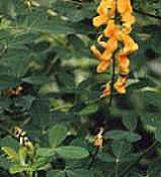Crotalaraia longirostrata
Chipilin
Tropical

Introduction
Chipilin is a wild plant that has become the source of a much-appreciated green leafy vegetable in Central America. It ranges from being a wild plant to a domesticated one. It may be planted near the house, protected if it appears in a field or simply harvested when it is found in wild stands farther away.
Chipilin is an erect perennial legume growing about 5 feet (1.5 meters) high. It is a very attractive plant whose deep green foliage and beautiful yellow flowers grace many homes in Central America. It grows very quickly during the rainy season from May to November and will produce edible leaves for up to six years before it needs replacing. Chipilin, like moringa, is a plant that could become much better utilized over a much larger area in the future.
Pros
- 10 grams dried chipilin leaf meal contains 25% of the iron required by a 4-6 year old child. It is not clear how biologically available that iron is, but given the magnitude of iron deficiency anemia in children and women, it warrants further investigation.
- Dried chipilin leaves are about 34% protein and only 10% fiber.
- A rich source of calcium and beta-carotene
- Greens are tasty and mild flavored.
- Chipilin is available in markets in Central America.
- Leaves are easy to harvest by stripping off between thumb and forefinger and small enough to not need chopping before drying
- A strong nitrogen fixer that improves the fertility of the soil
Cons
- Very little detailed information is available on chipilin. While it has been widely eaten in Central America since pre-Columbian times, the quantities eaten are usually small amounts in soups. Until more information is available chipilin should be eaten in moderation.
- Many members of the crotalaria family are poisonous. Crotaline and other alkaloids are especially dangerous in the seeds of some of the common crotalarias. These include wild species like C. spectabulis (rattlebox) and C. retusa.
- Because it is mainly grown for home use or casually marketed in rural towns, there has not been sufficient financial motivation to breed improved varieties.
Notes
- Crotalaria juncea or Sunnhemp, a related species native to Southeast Asia, yields 8-12 tons dry matter per hectare with two cuts and no irrigation; and 15 -25 tons dry matter with 4 cuts and no irrigation.
- Chipilin could have great potential as a combination edible potherb and green manure plant.
Seeds
- Chipilin seeds are locally available where it is eaten in Central America. They are often just gathered from wild plants.
Related Plants with Edible Leaves
- Crotalaria vitellina and C. pumila are eaten as leaf vegetables in Guatemala; C. ochroleuca (sunnhemp) and C. glauca eaten in tropical Africa; C. juncea (sunnhemp) is sometimes eaten in India and Bangladesh.